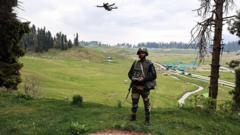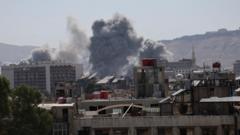The recent hostilities between India and Pakistan, characterized by allegations of drone strikes and missile attacks, indicate a dangerous evolution in their conflict, with expert commentary highlighting the implications of drone warfare for both nations in this nuclear-tensed region.
Escalation of Tensions: The Emergence of Drone Warfare in the India-Pakistan Conflict

Escalation of Tensions: The Emergence of Drone Warfare in the India-Pakistan Conflict
The longstanding rivalry between India and Pakistan has escalated as both nations engage in drone warfare, marking a significant shift in military strategy.
The longstanding conflict between India and Pakistan has entered a perilous new phase with the emergence of drone warfare, a development that raises serious concerns about further escalation. On Thursday, India accused Pakistan of conducting drone and missile strikes against Indian military bases, particularly in the disputed Jammu and Kashmir region. Pakistan promptly denied these allegations, asserting that it had intercepted and shot down 25 Indian drones. The absence of a direct response from India suggests a tense silence amidst the ongoing conflict.
As both sides engage in these aerial confrontations, experts are increasingly worried about the implications of such actions. The use of drones, described as silent, remote, and deniable, introduces a new dynamic that could potentially escalate tensions between these nuclear-armed neighbors. Jahara Matisek, a professor at the US Naval War College, has indicated that the mastery of drone technology could play a crucial role in determining the course of military engagements in South Asia.
Reports indicate that since Wednesday, cross-border exchanges of fire have resulted in significant casualties, with both sides suffering losses. India claims its attacks were in response to a militant assault that killed tourists while Pakistan maintains that it was not involved. The ongoing back-and-forth of accusations and counter-attacks marks a notable shift in the traditional military strategies employed by both nations.
Pakistan's military has claimed accomplishments in thwarting what it describes as Indian incursions, while India has emphasized its advancements in drone technology, unveiling a future strategy that includes high-altitude reconnaissance and precision strikes from unmanned vehicles. Notably, India's impending acquisition of MQ-9B Predator drones from the U.S. represents a significant enhancement of its capabilities, while Pakistan boasts a diverse array of drones, including advanced systems from China and Turkey.
Yet, experts maintain a cautious viewpoint on the drone warfare tactics presently being employed in this conflict. As Manoj Joshi, an Indian defense analyst, suggests, the use of drones reflects a restrained military option compared to full-scale aerial offensives involving manned aircraft. However, there are fears that this trend could lead to greater military confrontations if either side perceives a need for an expanded response.
Ultimately, as both nations continue to engage in this newly adopted drone-centric warfare, analysts warn that the stakes of further escalation are high. The situation remains fluid, with the potential for either de-escalation or intensification hanging in the balance, leaving observers across the globe on edge regarding the future stability of South Asia.
As both sides engage in these aerial confrontations, experts are increasingly worried about the implications of such actions. The use of drones, described as silent, remote, and deniable, introduces a new dynamic that could potentially escalate tensions between these nuclear-armed neighbors. Jahara Matisek, a professor at the US Naval War College, has indicated that the mastery of drone technology could play a crucial role in determining the course of military engagements in South Asia.
Reports indicate that since Wednesday, cross-border exchanges of fire have resulted in significant casualties, with both sides suffering losses. India claims its attacks were in response to a militant assault that killed tourists while Pakistan maintains that it was not involved. The ongoing back-and-forth of accusations and counter-attacks marks a notable shift in the traditional military strategies employed by both nations.
Pakistan's military has claimed accomplishments in thwarting what it describes as Indian incursions, while India has emphasized its advancements in drone technology, unveiling a future strategy that includes high-altitude reconnaissance and precision strikes from unmanned vehicles. Notably, India's impending acquisition of MQ-9B Predator drones from the U.S. represents a significant enhancement of its capabilities, while Pakistan boasts a diverse array of drones, including advanced systems from China and Turkey.
Yet, experts maintain a cautious viewpoint on the drone warfare tactics presently being employed in this conflict. As Manoj Joshi, an Indian defense analyst, suggests, the use of drones reflects a restrained military option compared to full-scale aerial offensives involving manned aircraft. However, there are fears that this trend could lead to greater military confrontations if either side perceives a need for an expanded response.
Ultimately, as both nations continue to engage in this newly adopted drone-centric warfare, analysts warn that the stakes of further escalation are high. The situation remains fluid, with the potential for either de-escalation or intensification hanging in the balance, leaving observers across the globe on edge regarding the future stability of South Asia.






















